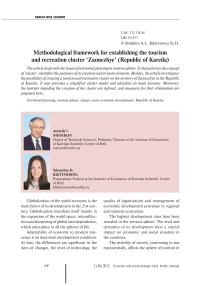Methodological framework for establishing the tourism and recreation cluster ‘Zaonezhye’ (Republic of Kareila)
Автор: Shishkin Anatoliy Ivanovich, Biktimirova Yekaterina Dmitriyevna
Журнал: Economic and Social Changes: Facts, Trends, Forecast @volnc-esc-en
Рубрика: Branch-wise economy
Статья в выпуске: 2 (26) т.6, 2013 года.
Бесплатный доступ
The article deals with the issues of territorial planning in tourism sphere. It characterizes the concept of ‘cluster’, identifies the purposes of its creation and its main elements. Besides, the article investigates the possibility of creating a tourism and recreation cluster on the territory of Zaonezhye in the Republic of Karelia. It also provides a simplified cluster model and identifies its main features. Moreover, the barriers impeding the creation of the cluster are defined, and measures for their elimination are proposed here.
Territorial planning, tourism sphere, cluster, socio-economic development, republic of karelia
Короткий адрес: https://sciup.org/147223460
IDR: 147223460 | УДК: 332.338.48
Текст научной статьи Methodological framework for establishing the tourism and recreation cluster ‘Zaonezhye’ (Republic of Kareila)
Globalization of the world economy is the main factor of its development in the 21st century. Globalization manifests itself mainly in the expansion of the world space, intensification and deepening of global interdependence, which takes place in all the spheres of life.
Adaptability of economy to modern processes is an important development condition. At that, the differences are significant in the rates of changes, the level of technology, the quality of organization and management of economic development processes in regional and national economies.
The highest development rates have been revealed in the services sphere. The level and dynamics of its development have a crucial impact on economic and social situation in the countries.
The mobility of society, continuing to rise exponentially, affects the sphere of tourism in the first place. This is confirmed by the fact that tourism development has been recognized as an economic phenomenon of the 20th century. Moreover, according to forecasts, its development will continue in the 21st century at a more rapid pace.
The tourism industry in Russia as a most important mechanism for the recovery of its economy exerts a stimulating impact on the socio-economic development of society. The RF Government approved the federal target programme ‘Development of domestic and inbound tourism in the Russian Federation (the years 2011 – 2018)’. It is an important tool and a legal framework of the state support to the sector.
The outbound tourist flow is characterized by the tendency of increase in the number of tourist trips of Russians, only during the crisis period of 2008 – 2009 there was an insignificant reduction in the demand (fig. 1) .
For the 2005 – 2008 period, the number of inbound tourism arrivals has been increasing annually. After that it reduced because of the global financial crisis. The number of foreign tourists amounted to 2.134 million people in 2010, and in 2011 it was 2.336 million people, which is 9% more. In 2011, the biggest number of tourists came from Germany (346627 people). The maximum increase of tourists in 2011 was from China – 48%, 158061 Chinese tourists visited Russia in 2010, while in 2011
Figure 1. Dynamics of domestic, inbound and outbound tourism in Russia
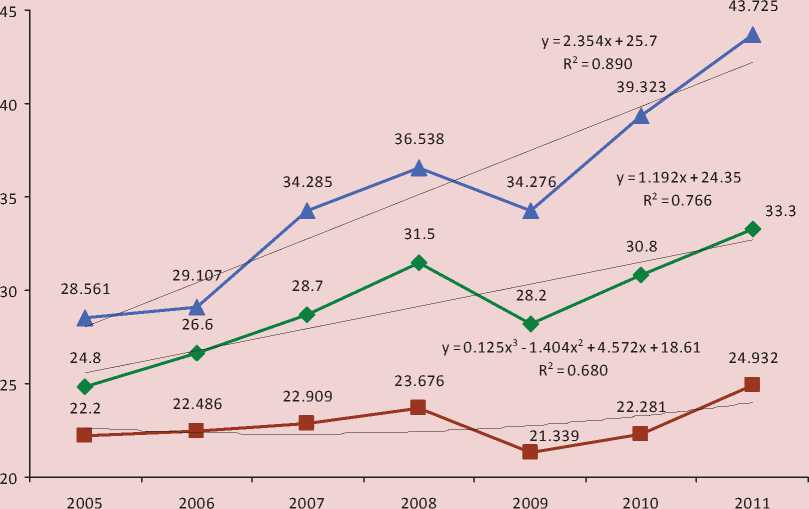
♦ Dynamics ofdomestic tourist flow in Russia, mln. people
— ■ — Dynamics of inbound tourist flow in Russia, mln. tours
* Dynamics of outbound tourist flow from Russia, mln. tours
y = 2.354x + 25.7, y – dynamics of outbound tourist flow in Russia, mln. tours; x – number of years (after 2005 = 1); R2 = 0.890 – rate of the validity of approximation; y = 1.192x + 24.35, y – dynamics of domestic tourist flow in Russia, mln. people; x – number of years (after 2005 = 1); R2 = 0.766 – rate of the validity of approximation, y = 0.125x3 – 1.404x2 + 4.572x + 18.61, y – dynamics of inbound tourist flow in Russia, mln. tours; x – number of years (after 2005 = 1); R2 = 0.680 – rate of the validity of approximation.
their number amounted to 234127 people. Turkey ranks 2nd after China, with the increase of 43%, and Cuba ranks 3rd (42%). The top 10 countries, the citizens of which visited Russia, included Germany, China, the USA, Finland, Great Britain, Italy, Spain, France, Turkey and Israel.
The domestic tourist flow is characterized by low rates. They start to increase in 2010, and by 2011 the greatest indicator has been achieved – 24.932 million trips.
Tourism development is especially accelerated by the following factors: improvement of population’s life quality, increase in the amount of spare time, economic and political stability, development of transport and information technologies.
The main development trends in the sphere of tourism are as follows: diversification of the tourist product, search for new tourism destinations, reduction of the average length of tourist trips, selection of alternative accommodation means, use of transport and information support of tourist products (the Internet).
The ongoing changes require new forms of cooperation for participants of tourist market in the regions. Clusterization1 of space is a modern form of business cooperation.
The prerequisites for understanding the clustering process as a special phenomenon in economy emerged in the 19th century on the basis of A. Marshall’s ideas of ‘localized industry’ as the concentration of specialized sectors in specific areas [6].
In 1990, M. Porter, exploring the development of 10 industrial countries, revealed that the emergence of clusters is a consequence of economic development and an integral part of industrialization.
According to M. Porter, a cluster is a group of interconnected companies, specialized suppliers, service providers, financial institutions, firms in related industries, concentrated according to geographical principle, and organizations associated with their activities [10].
The studies of approaches to the interpretation of the concept (tab. 1) defined 7 key elements characteristic of clusters:
-
1) geographical concentration;
-
2) wide range of participants and the presence of ‘critical mass’;
-
3) specialization;
-
4) innovation;
-
5) links and interaction between the participants of clusters;
-
6) competition and cooperation;
-
7) life cycle.
One of the first scientists, who attempted to apply the concept of industrial cluster in the sphere of tourism, was M. Monford. The concept of tourist cluster, in his opinion, which we support, includes 7 aspects:
-
1. Services provided by tourism enterprises or businesses (accommodation enterprises, restaurants, cafes, tourist agencies, aquaparks, theme parks, etc.).
-
2. Wealth (pleasure), obtained as a result of holidays and recreation.
-
3. Multi-aspect cooperation of interconnected companies and sectors.
-
4. Well-developed transport and communications infrastructure.
-
5. Complementary activities (commercial appropriations, recreation traditions).
-
6. Support services (information).
-
7. Natural resources and institutional policy.
This direction was explored in the works of M. Beni, A. Rodriguez, S. Nordin. For the first time in professional literature, the concept of tourism clusters was substantiated by S.I. Sokolenko and, further on, the concept of ecotourism clusters – by D.M. Stechenko and K.A. Andryushchenko.
Table 1. Evolution of approaches to the interpretation of the concept “cluster”
|
Author, source |
Interpretation of the concept “cluster” |
|
Schmitz [ 13 ] 1992 |
Cluster is a group of enterprises belonging to one sector and acting in close cooperation with each other |
|
Rosenfeld [ 12 ] , 1997 |
A concentration of enterprises, receiving a synergetic effect due to their geographical proximity and interdependence; a geographically bounded concentration of similar, related or complementary commercial activities with active channels for business transactions, communications and dialogue, which determines the specialized infrastructure, labour markets and services and which is faced with common opportunities and threats |
|
Egan [ 15 ] , 2000 |
A cluster is a form of industrial organization, which depends on the networks of highly specialized, interconnected firms of private sector and institutions of public sector, the final products of which enter the markets outside the central region |
|
Steiner and Hartmann [ 14 ] , 2001 |
A cluster is a number of related and complementary firms of public, private and quasipublic research institutes and development institutes |
|
OECD [ 16 ] , 2001 |
Regional clusters are geographically limited concentrations of interconnected firms and can be used as a keyword for older concepts like industrial areas, specialized industrial agglomerations and local production systems |
|
Yu.A. Arutyunov [ 1 ] , 2008 |
A cluster as a set of “4 C’s”: 1) concentration 2) competition within the cluster in order to attract customers, 3) cooperation, 4) competitiveness |
|
Guidelines for the implementation of cluster policy in the RF subjects [ 7 ] , 2008 |
Territorial clusters are the associations of enterprises, suppliers of equipment, component parts, specialized production and maintenance services, scientific-research and educational organizations, that are bound by the relations of territorial proximity and functional interdependence in the sphere of production and selling of goods and services |
|
G.B. Klainer [ 4 ] , 2009 |
Clusters as a set of four types of systems: 1) objects, 2) processes, 3) environments, 4) projects |
|
M.Voynarenko [ 2 ] , 2011 |
The concept of “5 I’s”: Integration, Initiative, Interest, Innovations, Information |
The role of technology in tourism clusters is performed by the route organization of processes. Tourism flows form the basis of the cluster.
Such cooperation can be created spontaneously or with the help of a coordinating body (the public and state authorities). The purposes of creating a tourism cluster are as follows:
-
• mutually beneficial cooperation with the maintenance of competition between the subjects of the cluster;
-
• enhancement of competitiveness of each of the enterprises;
-
• provision of entrepreneurs with new opportunities to use the authority of the cluster;
-
• the most efficient promotion of their initiatives through federal structures, including the drafting of laws;
-
• attraction of investors.
The most important components of a tourism and recreation cluster are:
-
1. The core of a tourism cluster, which may be represented by cultural and natural heritage sites or other objects of tourism interest (for example, a ski resort).
-
2. Tourism enterprises (tour operators).
-
3. Service providers, i.e. the enterprises providing accommodation, feeding, transportation of tourists.
-
4. Maintenance organizations – communal services; first responders; credit, insurance, legal, consulting companies; educational institutions; companies producing souvenirs, etc.
In Russia, the Government shows an increasing interest to clusters. In 2010 the strategy for innovation development of the Russian Federation for the period up to 2020 was worked out, a substantial part of which is devoted to the clusterization of regions [11].
The formation of a number of regional and local clusters began after the adoption of the Federal Law ‘On the special economic zones in the Russian Federation’. A number of projects on the special economic zones of tourism and recreational type were developed: in Krasnodar and Stavropol krais, the Kaliningrad Oblast, the Republic of Buryatia, the Irkutsk Oblast, Altai Krai and the Altai Republic. The development was the most successful in the SEZ of the Altai.
The international practice recognizes the following clusters as successful ones: the coasts of the Mediterranean and the Adriatic seas, the Caribbean region; the United Arab Emirates; ski resorts of the Alps; entertainment industry in Las Vegas and Hollywood.
Russia has only recently started to develop the cluster approach to the organization of tourism. Its successful projects include Yasnaya Polyana (the core of this cluster is the state memorial and natural preserve “Museumestate of Leo Tolstoy ‘Yasnaya Polyana”), the tourism cluster of Krasnodar Krai, the regions of Western Siberia, etc.
The Republic of Karelia is attractive for tourists due to its natural, cultural and healthimproving sites (‘Marcial Waters’ resort, the open-air museum preserve of wooden architecture ‘Kizhi’, the Valaam archipelago).
At present, the total flow of tourists in the region is estimated by expert methods. In this case we mean all the tourists who visited the Republic, including individuals, arriving as guests. According to this assessment, the total number of visitors of Karelia has increased almost by a quarter for the last decade (fig. 2) .
At the same time, in the crisis period there has been a decline (the number of visitors in 2009 as compared to 2008 has decreased by 10%).
The linear trend makes it possible to carry out an assessment forecast. The dynamics of the number of visitors of the Karelia Republic is characterized by a rising tendency. The quality of approximation is low (R2 = 0.5947), consequently, the long-term forecast is not provided. The largest number of intersections was in 2008 – 1.83 million people.
Figure 2. Dynamics of the total number of visitors, million people, the share of organized tourists in the Republic of Karelia, %
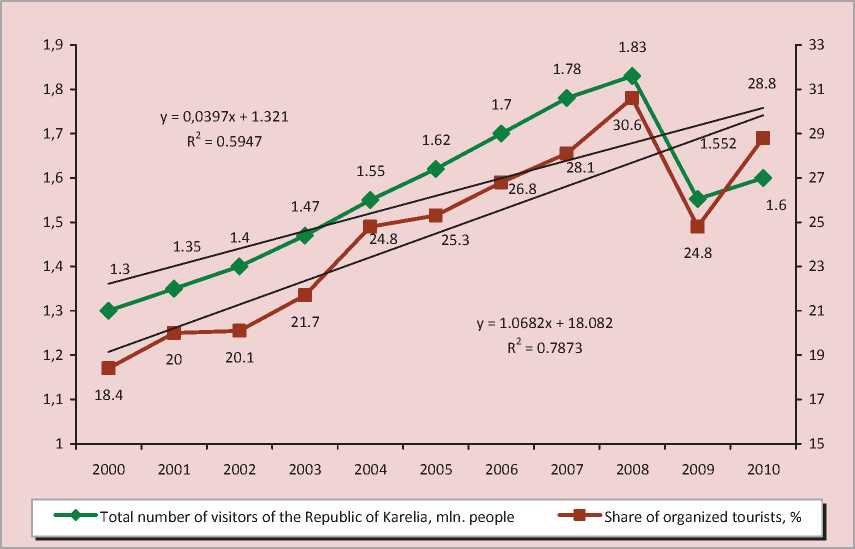
y = 0.0397x + 1.321, y – total number of visitors of the Republic of Karelia, mln. people.; x – number of years (after 2000 = 1); R2 = 0.5947 – rate of the validity of approximation; y = 1.0682x + 18.082, y – share of organized tourists, %; x – number of years (after 2000 = 1); R2= 0.7873 – rate of the validity of approximation.
The share of organized tourists is increasing, excluding the indicator of 2009. According to estimates, there is a possibility to balance the indicators by 2015. It is connected, in the first place, with the development of the infrastructure and integrated policy in the tourism sphere.
At present, tourists arrive in the Republic of Karelia from several directions. The main tourist flow consists of the residents from other Russian regions, first of all, Moscow and Saint Petersburg. They arrive mainly by rail (up to
95% of the total number of organized tourists), motor vehicles (including on their own), by cruise liners. The share of foreign tourists in certain kinds of tourism can reach 30% (cultural and cognitive tourism); some of them come from Moscow and Saint Petersburg, some cross the Russian-Finnish border through the border crossing points, located on the territory of the Republic. A small part of the tourists arrive from the Murmansk Oblast, including transit tourists (fig. 3) .
Figure 3. Distribution of the tourist flow in the Republic of Karelia
White Sea
\ 3% of the tourist flow
International Automobile BorderCrossing Point Kuusamo-Suoperän sk Oblast
Murman
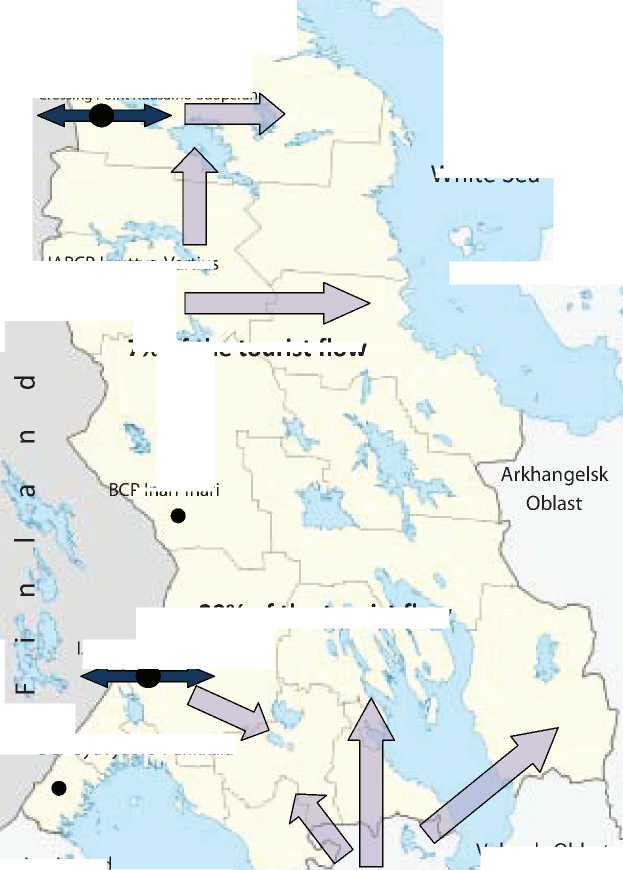
7% of the tourist flow
P Inari-Inari
/ 20% of the tourist flow IABCP Niirala-Vyartsilya
Vologda Oblast
J* Leningrad Oblast
Leningrad Oblast
IABCP Lyuttya-Vartius
BCP Syuvyaoro-Parikkala
-
5 main tourism centres were singled out on the basis of the general plan of tourism infrastructure facilities:
-
• Spasskaya Guba – Marcial Waters – Kivach.
-
• Priladozhye (Lakhdenpokhsky District, Sortavala, Valaam).
-
• Kizhi Necklace (Zaonezhye).
-
• Obonezhye (Besov Nos (Devil’s Nose), Muromsky Monastery, Vodlozersky National Park).
-
• Karelian Belomorye (Belomorsky and Kemsky districts, Solovki)
The Central area of the tourism zone is a most attractive one in terms of tourism and recreational potential development in the Republic of Karelia.
It is considered to be a promising tourism zone, located within Medvezhiegorsky and Kondopozhsky municipal districts, as well as the territory of Petrozavodsk. (Prionezhsky District; fig. 4 ).
The Patriarch of Moscow and All Russia Kirill and the President of the Republic of Karelia A.V. Nelidov proposed the idea of the megaproject ‘Spiritual Transformation of the Russian North’. It is based on 3 main historical spiritual centres (Solovki, Valaam, Kizhi). The project’s mission is to preserve and summon up the potential of spiritual and cultural heritage of the Russian North for the development of human capital as the basis of modernization and sustainable innovation development of the North-West of Russia (fig. 5) [5].
Figure 4. Map of the Central area
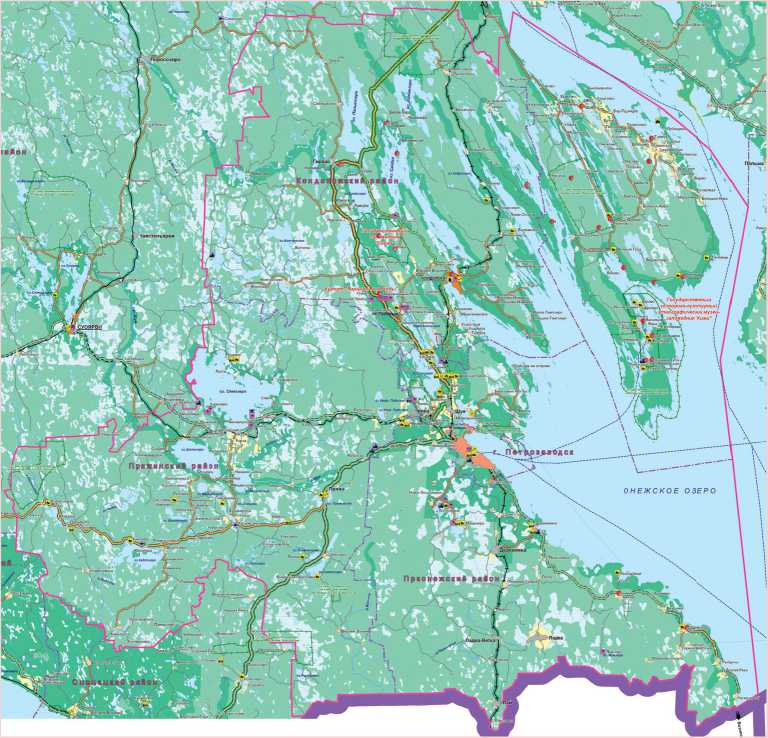
Figure 5. Map of the project ‘Spiritual Transformation of the Russian North’
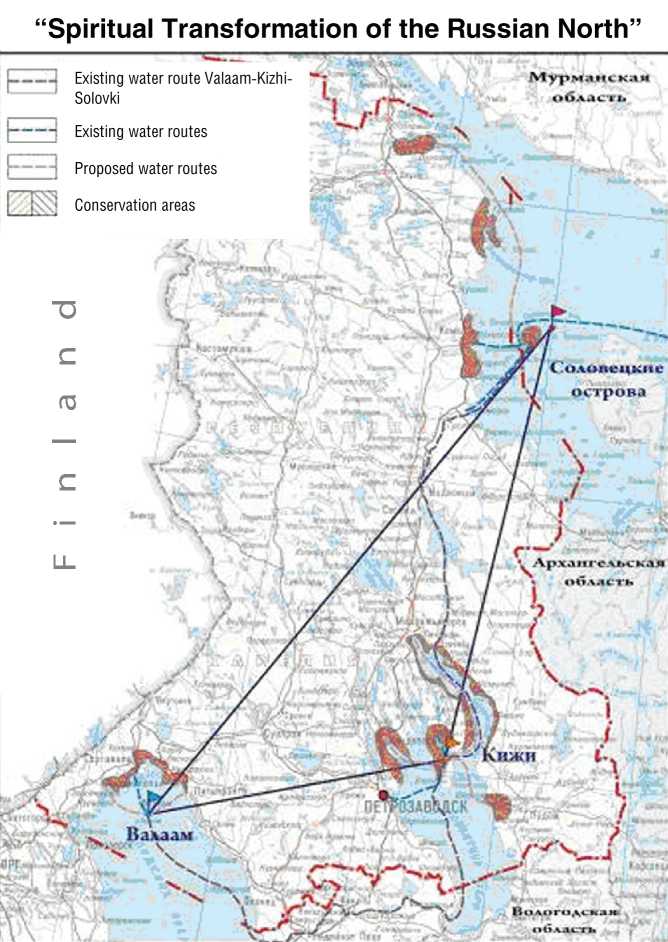
This fact proves the necessity of studying the opportunities for creating local tourism clusters in the Republic of Karelia.
The territory of Zaonezhye is suitable for creating a local cluster, the core of which consists of the world heritage site (WHS) ‘Kizhi Pogost’ and the relations established between the participants of tourism business.
In order to reflect these relations, a tourism cluster scheme has been developed. Its essential elements are defined through the identification of tourism resources (fig.6) . The unique character of tourist resources, the local traditions and recreation culture influence the choice of specific features of the tourism cluster, the process of its formation and determination of the main tourist products.
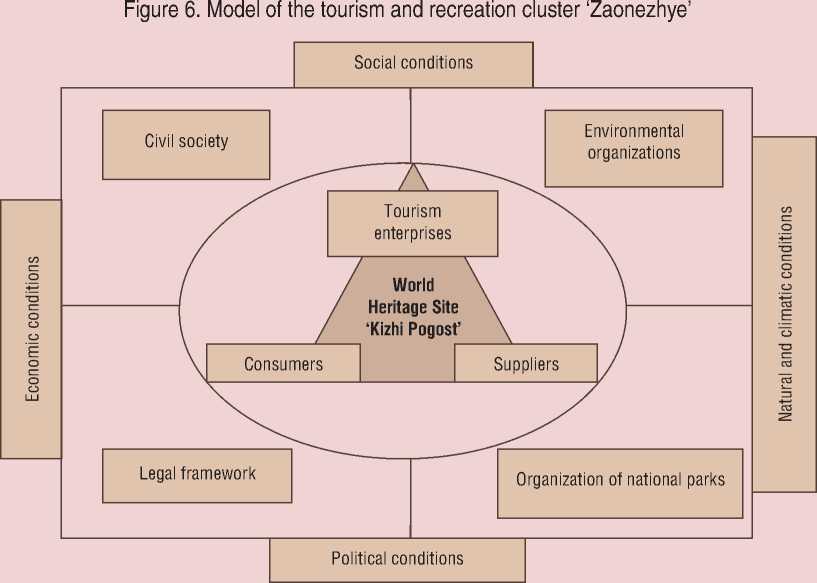
The main components of the tourism and recreation cluster ‘Zaonezhye’ model are as follows.
-
1. World heritage site, the Kizhi Pogost ensemble, includes the unique monuments of wooden architecture: two churches and a belltower. These buildings, being of different height and shape, nevertheless constitute a single and a very picturesque ensemble, which fits perfectly into the austere landscape.
-
2. Tourism companies are divided into those belonging to small and large businesses, and the local and Russian ones. The local companies include LLC Tourism Company Russkiy Sever, LLC Tourism Company Kizhi Necklace, CJSC Intourist-Petrozavodsk, LLC Lukomorye, LLC Toutist Bureau KORELA; the Russian companies include Tourism Company Arina, LLC LADA, LLC Istoki-S, LLC Radonezh Pilgrimage Service, LLC GAMA, LLC Tourism Company MIR and others.
-
3. Services are provided by hotel enterprises (in the town of Medvezhyegorsk: hotel
-
4. Consumers: the residents of the Republic of Karelia and other regions of the Russian Federation, foreign citizens.
-
5. Environmental organizations: the Ministry of Natural Resources and Ecology of the Republic of Karelia; the Federal State Institution White Sea and Lake Onega Waterways and Shipping Administration (FSI Belomorkanal); Karelian Regional Public Environmental Organization SPOK, etc.
-
6. Legal framework: legislation of the world heritage sites, rural settlements, municipal districts, federal legislation.
-
7. Civil society: the regional branch of public organization the Union of Architects of Russia; the World Heritage Conservation Fund; the Club of friends of the Museumpreserve ‘Kizhi’; Karelian regional public organization of Russian culture ‘Russian North’; the Guild of master craftsmen of decorative and applied arts of the Republic of Karelia; the ethno-cultural centre ‘Tuomi’; the Vepsian Culture Society; the club ‘Regional Ethnographer’; the fund ‘Russian World’ (Finland); Karelian regional public organization ‘Young Karelia’; Karelian regional public organization ‘Zaonezhye’.
-
8. Organization of national parks – the Federal State Budgetary Institution National Park ‘Vodlozersky’.
Onezhskaya, country club Malaya Мedvezhka, mini-hotel Beliye Nochi; in Medvezhiegorsk District: country eco hotel Bolshaya Medveditsa in the rural settlement of Voyguba, guest house Zaonezhye in the rural settlement of Velikaya Guba, recreation facility in the rural settlement of Shunga, etc.); transportation companies (LLC Vodokhod-Saint-Petersburg, LLC ; LLC Karelia Flot; LLC Russkiy Sever; airport Peski); souvenir manufacturers (Sole Proprietor Grischuk – retail sale of souvenirs and craftwork); public catering, etc.).
The research revealed the characteristics necessary for assessing the tourism cluster ‘Zaonezhye’ (tab. 2) .
The study confirmed the possibility of creating the tourism and recreation cluster ‘Zaonezhye’. It also identified the barriers preventing its establishment [8].
-
1. The lack of centralized infrastructure facilities to provide services for the tourists.
-
2. The lack of information support along the roads, as well as the marking of natural and cultural heritage sites (information stands).
-
3. The absence of interactive programmes.
-
4. The territorial plans do not contain measures on the development of tourism on the territory of Zaonezhye (including investment projects).
-
5. The image of the world heritage sites is not used to the fullest.
The road from the town of Medvezhye-gorsk to the rural settlement of Velikaya Guba is in a satisfactory condition. The road from Velikaya Guba to the village of Oyatevshchina is currently under construction, it will promote the development of transport links with the island of Kizhi. The present condition of the roadbed limits the tourist flow and hampers the entrepreneurs’ initiatives concerning the construction of tourism objects.
Tourist attractions are owned by municipal authorities. The efforts and funds of local authorities alone are not enough to mark all the objects and provide them with security systems. This led to the fact that some of them disappear because of vandalism or natural phenomena.
The development of the tourist route should include visiting the mainland sites and the world heritage sites of Zaonezhye and water excursions.
It has been recognized that all the identified barriers are possible to overcome. For this purpose, the following measures have been worked out:
-
1. Adjustment of territorial planning documents on the basis of an integrated approach to the development of the territory. The development of territorial planning documents should begin with the level of the object: object management plans, object marketing plans, business-plans, which are included in municipal plans, and these, in turn, are included in the regional programmes on the development of territories.
-
2. Appointment of executors and persons responsible for the creation of the cluster. It is the local authorities that should take the initiative in this matter. Successful functioning of tourism clusters will depend on the efficiency of actions on the part of state authorities. The experience of delegation of coordinating functions to specially created organizations (public organizations on the basis of publicprivate partnership) and marketing centres can be also used.
-
3. Carrying out an inventory of tourist resources. Making up a tourist map of the cluster.
-
4. Creation of a package of investment proposals for the development of Zaonezhye.
Table 2. Assessment characteristics of the tourism cluster ‘Zaonezhye’
Characteristics
Details
Cluster borders
The Zaonezhsky peninsula in the northern part of Lake Onega, Medvezhyegorsky District of the Republic of Karelia
Tourist resources
-
• 126 architectural monuments,including the ensemble of the island of Kizhi, residential houses, churches, chapels in the rural settlement of Kosmozero, the villages of Tambitsy, Yandomozero, Ust-Yandoma, Vegoruksa
-
• 71 archeological monuments (including petroglyphs, the neolythic settlement of Pegrem)
-
• 46 settlements having the status of ‘historical’
-
• Springs believed to possess healing qualities: ‘Three Ivans’, ‘Solyanaya Yama’, ‘Yeseninsky’, ‘Tsaritsyn stream’
-
• Paleostrovsky monastery
Tourism types
-
• Cultural and educational
-
• Ecological
-
• Pilgrimage
-
• Recreational
-
• Sport (active)
Tourist products of the cluster
-
• Tourist route ‘Silver ring of Zaonezhye’
-
• Tourist route ‘Ancient history of Zaonezhye’
-
• Tourist route ‘Kizhi necklace’
-
• Tourist route ‘Geological chronicle of Zaonezhye’
-
• Excursion to the island of Kizhi
-
• Health promotion tour ‘Healing springs of Zaonezhye’
-
• Fishing and hunting tours
-
• Jeep safari
-
• Network of stationary tourist products ‘Rural life of Zaonezhye’
-
• Other city breaks
Tourism infrastructure
Guest homes, catering enterprises
Tourists’ expenses
Payment for entrance tickets, tourists buses; fuel (when travelling on one’s own), meals, rent, transport, guides
Transport
Bus service, private car, water transport
Accommodation
Guest homes
Meals
Arranged in catering enterprises, on one’s own
Supporting spheres
-
• Communal services, first responders
-
• Credit, insurance companies
-
• Legal, consulting, audit companies
-
• Production of souvenirs
-
• Educational establishments
Environmental conditions
Relatively mild winter; short, cool summer. Pronounced seasonality
Education, science
Museum and educational activity of the museum-preserve Kizhi; scientific and educational establishments of Petrozavodsk (Karelian Scientific Centre of RAS, Petrozavodsk State University, Karelian Institute of Tourism, etc.)
Local authorities
Velikogubskoye rural settlement
Medvezhyegorsky Municipal District
Associations
Karelian regional public organization ‘Zaonezhye’
Karelian regional public organization of Russian culture ‘Russian North’
-
-
5. Identification of funding sources, including on the basis of public-private partnership.
-
6. Creation of preferences for the development of small entrepreneurship on the territory of the cluster.
-
7. Creation of an association of guest homes’ owners. This association will provide
-
8. Comprehensive information and advertising support of the territory. It is necessary
entrepreneurs with new opportunities for the systematization of emerging problems, the choice of the ways to overcome them. Using the influence and authority of the cluster, they can seek ways for the most effective promotion of their initiatives together.
to include the event tourism activities of Zao-nezhye into the implemented tourist products and also into the annual action plan of the Republic of Karelia.
Scientifically grounded formation of the cluster on the territory of Zaonezhye, subject to successful management, will result in the following:
-
– replenish the regional budget at the expense of increasing tax revenues;
– enhance the competitiveness of the territory on the tourism market;
– create prerequisites for the development of innovations;
– influence the formation of the positive image of the territory;
– enhance the work of the private sector in the organization of employment of local population;
– preserve the cultural and historical monuments of Zaonezhye under the conditions of the territory’s infrastructure development.
Creation of the tourism cluster in Zaonezhye as a point of growth of tourism sphere in the Republic of Karelia will establish conditions for the formation of new businesses and will provide an opportunity for increasing the competitiveness of the economic entities and territory of Zaonezhye.
Список литературы Methodological framework for establishing the tourism and recreation cluster ‘Zaonezhye’ (Republic of Kareila)
- Arutyunov Yu. A. Formation of the regional innovation system on the basis of cluster model of the region’s economy. Corporate management and innovation development of the economy in the North: Bulletin of the research centre of corporate law, management and venture investment of the Syktyvkar State University, 2008. Vol. 4.
- Voynarenko M.P. Cluster in institutional economics: monograph. Khmelnitskiy: Khmelnitsky National University, ‘Triada-M’, 2011.
- The general plan of tourism infrastructure facilities in the development of the Scheme of territorial planning of the Republic of Karelia. Saint Petersburg, 2007.
- Klainer G.B. The first cluster. Tourism: practice, problems, prospects. 2009. No. 10. P. 17 -19.
- OJSC Corporation of Development of the Republic of Karelia. The Republic of Karelia, 2011.
- Marshall A. The foundations of economics: in 3 vol. Moscow, 1993. Vol. 1.
- Methodological recommendations on the implementation of cluster policy in the Northern regions of the Russian Federation. Available at: http://www.tpprf.ru.
- Report on the implementation of the research on the ‘Development of the Management Plan for the World Heritage Site ‘Kizhi Pogost (Russia S 544)’ from 2012 to 2022’ (contract No. 34/11 dated June 30, 2011).
- Shishkin A.A., Shishkin A.I. Organization, planning and management of construction production: education guidance. Petrozavodsk: Publishing house of Petrozavodsk State University, 2007.
- Porter M. Competition. Moscow, 2005.
- Strategy of innovation development of the Russian Federation for the period up to 2020. Available at: www.rg.ru/pril/63/14/41/2227_strategiia.doc
- Rosenfeld S.A Bringing business clusters into the mainstream of economic development. European planning studies. 1997. No 5. P. 3-23.
- Schmitz H. On the clustering of small firms. In: Flexible specialization: a new view on small industry. IDS Bulletin. No. 23(3). P. 64-69.
- Steiner M., Hartmann C. Looking for the Invisible: material and immaterial dimensions of clusters. Paper presented at the Regional Studies Association Annual Conference on ‘Regionalising the Knowledge Economy’, November 21, London, 2001.
- Toronto competes: an assessment of Toronto’s global competitiveness. City of Toronto. Economic Development Office, 2000.
- World Congress on local clusters: local networks of enterprises in the world economy. OECD: Paris, 23 -24 January 2001.

